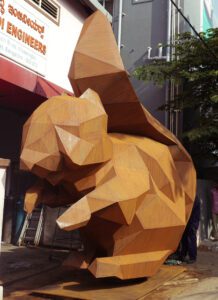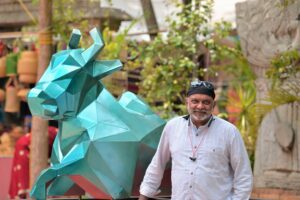Kalyan S Rathore's 'The Squirrel', which is 15 ft tall, weighs around 2.5 tonnes, and is made in 15 days using Corten, an alloy of steel.

Kalyan S Rathore's Squirrel sculpture has been chosen to adorn the Ayodhya Railway Station. (Supplied)
Legend has it that when Lord Rama needed to build a bridge across the sea to the island of Lanka to rescue his wife Sita, a tiny squirrel decided to help. The little squirrel began picking sand and little by little, and gathered an entire heap. Touched by the gesture, Rama blessed him.
The story of the squirrel’s unselfish act was the inspiration behind Bengaluru-based sculptor Kalyan S Rathore’s creation which will adorn Ayodhya Railway Station’s atrium later this month.
“The squirrel dedicated itself selflessly, without being conscious of what a tiny creature like itself will be able to do. I found that message very interesting,” says Rathore, adding that he hopes the installation will bring to the fore the essence of contributing to society without prejudice.
“It conveys that though we may be insignificant as individuals, we can become one with the driving force behind any noble cause,” he tells South First.
Rathore felt so strongly about his subject of choice that he submitted only one pitch to reviewers.
“I totally believed in its story and the deeper message of alilu seve, as it is commonly known in Kannada. It translates to ‘squirrel’s service’ and describes the act by people to help in whatever capacity they can. The idea is that it doesn’t matter how small your help is, it’s the helping mentality that’s important,” he adds.
Rathore’s style of sculpting has always been geometric and narratives based on mathematics.

The Squirrel that is 15 feet tall, and weighs around 2.5 tons is made of Corten. (Supplied)
“When I got the opportunity to pitch for the Ayodhya Railway Station, my only concern was if they would be expecting something traditional such as deities,” he explains.
But he was sure that it had to be something different than what most would expect. And so, he decided to go for it in his own contemporary style.
“Now, I believe that an the out-of-the-box idea is what appealed to them,” he says, certain that every passerby would get the message he’s trying to convey.
“When your eyes have seen too many of the same style of works, what can break the monotony is when someone is trying to portray the same message but with a different language,” he adds.
‘The Squirrel’ is 15 feet tall, weighs around 2.5 tonnes, and is made of Corten, an alloy of steel.
“Corten is a kind of steel which gets rusty without actually corroding. It starts to look almost archeological. It’s quite popular in the West; but in India, not so much. People here might wonder why it looks old and rusty even though the technique looks contemporary. That would be one of my objectives for engagement,” he says.
Though a sculpture like this would normally have taken about 40 days to create, Rathore made it happen in just 15 days.
Explaining his process, he says, “I start with making sketches of the animal’s basic characterisation where I decide what features I want to highlight. After the two dimensional sketching stage, I cut it out on paper to judge the proportions and ratios. After the paper model comes the mathematical assessment of its geometry. Then I take it to the virtual space. I work on a 3D software before I sculpt it.”
There is a good amount of fractal geometry used in the process, he notes.
“It’s about looking at nature’s geometric forms. Be it a tree or when you cut a cauliflower, you see patterns that are self-replicating, growing, or diminishing. Sometimes when you are looking at an organic form, you see more wrinkles near the neck, or how the belly is large and smooth. This kind of texturization, when understood through geometry, will bring in a better resonance to life,” he points out.
While on one hand, Rathore uses hardcore industrial methods and mathematical principles to understand forms, on the other, he likes to observe the underlying nature of growth. And he credits a lot of his inspiration to have come from the city he grew up in.
“Growing up in the 1970s, living in the Bengaluru suburbs, invariably one gets to be in a green space. We had everything — sparrows, garden lizards, squirrels; they were our playmates. I think I have internalised a lot of the characteristics, behaviour, and the dynamics of these creatures,” he tells South First.
A self-taught artist, Rathore comes from an industrial design background. It wasn’t until 2008 that he moved to sculptures. While industrial design was creative to an extent, it made him want to push his boundaries further.
“I used to get visions in my sleep — of beautiful forms and almost apparently meaningless structures. So I decided to pursue it, and along the journey I stumbled upon several aspects and elements such as biomimicry,” he says.
However, Rathore attributes a lot of the factors that makes his work distinct to his design background.
“I believe I bring my history of meticulous design detailing to my art. Most artists would sculpt on clay or a piece of wood. I can’t do that to save my life (laughs). But I can look at things with a geometric predisposition of form,” he notes.
He explains, “It means when you look at an amorphous thing — be it a plant or a fruit — you start breaking it down to its basic geometry. When I do that, it becomes a lot more convenient for me to get it manufactured because it gives me all the data that I need.”
In the last 15 years, Rathore has done over 25 large sculptures and 200 small ones. His works are predominantly with materials such as stainless steel, copper, brass, and bronze.
“I do art shows with my smaller works. Larger ones can be found in tech parks, hotels, and a few public spaces. My recent work can be found in the Terminal 2 of Bengaluru airport. It’s called Efflorescence,” says Rathore.

Kalyan S Rathore (Supplied)
The city’s impact on Rathore’s life as well as his art is something he can’t talk enough about.
“I belong to the generation that has seen the old Bengaluru, the old BEML, HAL, and such,” Rathore says.
“My father was an aeronautical designer and I grew up 200m from the runway. My neighbours were all scientists, engineers and doctors. I used to love picking their brains. Those conversations have shaped me a lot. I have seen the city transform to the Bengaluru that’s on the international map now — the changing technology, the influx of a variety of cultures — it was all these things. I believe my formative years have had a big influence on my art,” he details.
As for his early influences in the art field, Rathore says it includes Henry Moore, who broke traditional sculpting with abstract exaggerations; Alexander Calder, who uses a lot of physics in his kinetic works, and Bengaluru’s own Yusuf Arakkal whose textures impressed Rathore even during a time he was not into art.

May 16, 2024

May 15, 2024

May 14, 2024

May 14, 2024

May 14, 2024

May 14, 2024